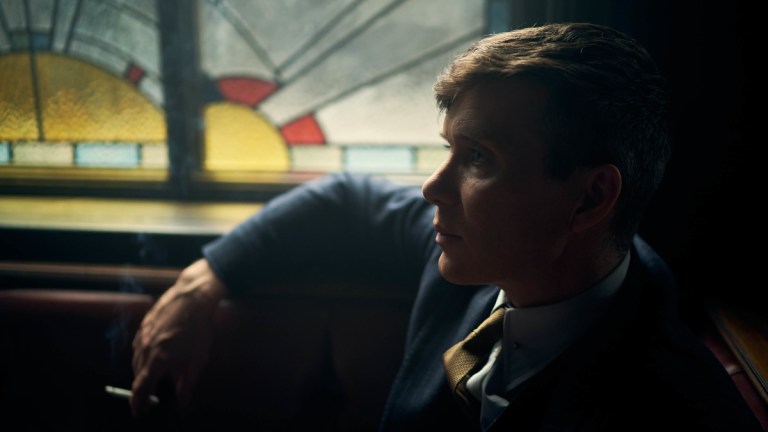Peaky Blinders Season 6 Finale Review: Lock and Key
Peaky Blinders says goodbye without really saying goodbye in a minor-key finale that turns explosive, with a thrilling twist. Spoilers.

Warning: this Peaky Blinders review contains spoilers.
Tommy escaped. He escaped it all – the fascists and the fake diagnosis and his family and himself. He rode out of Peaky Blinders just as he rode into it, only this time (this drama loves symbolism) on a white and not a black horse. Season six had sent him to hell where he’d reckoned with his sins. Then a plot by his enemies presented him with a rare opportunity to ride for the hills and leave it all behind. And as we know, Tommy’s never one to miss an opportunity. When Arthur and Curly and Charlie rake the ashes of Tommy’s wagon for silver and gold, they’ll find his wedding ring and watch and think him gone. He’s free.
Free, that is, until the Peaky Blinders feature film comes out, when Tommy Shelby or Mr Jones or the Duke of Saxon Shore or secret agent T or whatever name he’ll go by now, will presumably be back in business.
The follow-up film cast something of a shadow over this finale, which was unable to say a last goodbye to much because of a need to keep pieces in play for the future. Plots like Finn’s banishment from the family and rivalry with Duke felt accelerated to serve the film and not the series. Duke’s transformation from a nature-lover to a general in the Peaky Blinders army was similarly underexplored. The extended-length episode had one foot moving forwards and the other facing backwards, which left it at times, understandably struggling for balance.
That’s not to say there weren’t fireworks and gutsy choices. The razing of class-emblem Arrow House to make way for social housing was a thrilling act of vandalism against the establishment. Tommy had spent years trying to infiltrate the upper ranks before he understood that his family’s gypsy blood would never be accepted, despite his piles of cash. That house once represented his naïve attempt to join the aristocracy; blowing it up reconnected Tommy with his Communist youth and Romany heritage, as well as fulfilling Lizzie’s wish from the last episode. A literal blast.
And not the only one. The Miquelon car bomb and Garrison Lane shoot-out gave us more thrilling action. The first had sustained tension from the moment the bag containing the explosive appeared on screen to the moment of detonation. The second had unpredictability and artily unsettling images, from the vulnerable child who’d wandered into the middle of the shoot-out to the otherworldly sight of Arthur and co. in gas masks beneath the spitting sparks. As ever with this show, especially under Anthony Byrne’s direction, it basked in spectacle. The extra runtime allowed both sequences, and Billy Grade’s final ‘party’ an unhurried, feature-film pace.
In all three expertly spliced stories, Tommy was back to his familiar position of being several steps ahead. He’d bribed the French barman and smuggler in episode one, made the deal to sell his opium to Alfie back in episode two, learned from Gina that Michael was out for his blood in episode four, and fed Grade the false info in this finale. With all the right spies in all the right places, the multi-pronged revenge plan went like a dream. Duke took Billy out; Finn was ousted (never really trusted since he let slip the vital info that led to Polly’s murder); Johnny Dogs swapped the bombs and left Tommy a symbol on the door of the car it was safe to enter; and Arthur, Jeremiah and Charlie were ready and waiting with their WWI souvenirs for the IRA assassins in Garrison Lane.
Less intricately plotted, though a solid surprise for those who hadn’t suspected it (i.e. gullible me. Congratulations to everybody who had him pinned as a conman) was Tommy uncovering the Holford plot. ‘A ghost told me’ has to be the least satisfying way for a character of Tommy’s strategic genius to come to a revelation, but there it was. Ghost-Ruby appeared in a vision to stop Tommy from pulling that trigger and to direct him towards the evidence that Dr Holford was a Mosley plant all along. There was no incurable tuberculoma, no death sentence. It was all a scheme to hasten Tommy’s inevitable suicide and clear him away in time for the new world order. It was satisfying that Holford’s callous disregard for gypsies and instruction to burn the wagon turned out to be the very thing that set Tommy free.
There was no conclusion to the Mosley and Mitford story, no reappearance from Jack Nelson or Winston Churchill, but history gives us all we need. In 1940, four years after their Berlin wedding, new British prime minister Churchill had Mosley and Mitford imprisoned as likely to commit acts prejudicial to the safety of the realm. The British Union of Fascists was banned, and the pair never achieved the power once thought inevitable. Both went on to live long lives. As for Jack Nelson’s historical inspiration/counterpart Joseph P. Kennedy, he fathered one of America’s best-known dynasties including a future state senator and president.
Enough of the villains. This was an episode about the Shelbys – bad people, but our bad people. Despite her swagger being showcased earlier in the season, Sophie Rundle’s Ada sadly didn’t get much of a look-in, but Paul Anderson and Cillian Murphy killed it in their scenes as Arthur and Tommy. This whole season has been a horror show in a minor key, and their performances have shown utter commitment to telling this story with real humanity. For six episodes, creator Steven Knight told us with every trick going that Tommy Shelby – god, man, ghost – was moving towards death, and then in a swerve worthy of Tommy himself, instead gave the character a new lease on life. Bravo. Peace at last.
For now.
Peaky Blinders season six is available to stream in full on BBC iPlayer in the UK. It arrives on Netflix worldwide on the 10th of June.
